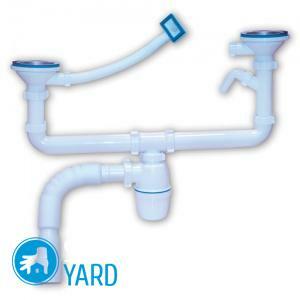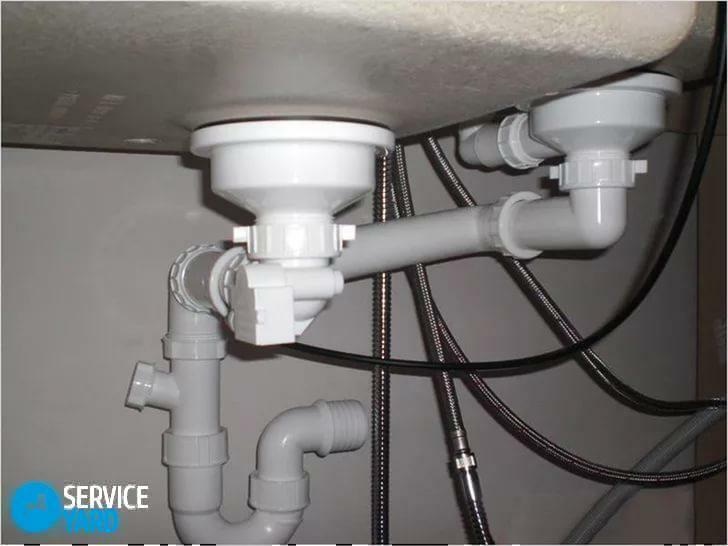
- Features of kitchen siphons
- Classification
- How is the bottle siphon arranged?
- How to assemble a siphon for cleaning?
- Service
- How to prolong the life of the drain system?
The kitchen sink is one of the most important attributes in the kitchen, and the siphon for sink is an indispensable part of it. There are several varieties of these products. All of these in combination are designed to prevent the penetration of foreign "sewer" smells into the kitchen. According to the principle of its action, it is a hydraulic seal, the curved part of which is filled with water. In addition, the device protects the sewer from clogging with solid particles( they settle down in the lower part of the device).More details about the design of the sink for the kitchen sink and its possible options you will learn from this article.
to the table of contents ↑Features of kitchen siphons
A modern construction made of polymer materials - polypropylene and polyethylene. Polymer devices have a number of advantages over products made of bronze or brass:
- A comparatively small mass( a sink made of thin-walled metal is not heavily loaded).
- Smooth plastic walls do not allow the accumulation of fatty deposits.
- Materials are not susceptible to rotting and corrosion.
- Long working life.
- Low cost.
Tips for choosing the device:
- The siphon for the kitchen sink is equipped with a nozzle to which the drain is attached - rigid or corrugated. It is advisable to choose a sink with a large diameter( 40 mm is enough).The standard of 32 mm clogs more often.
Important! In order to be able to connect a dishwasher or washing machine to a drain, it is recommended that you select a device with additional outlets.
- For kitchen preferred drain with overflow, which will not allow the overflow of the bowl of washing and flooding the kitchen. If the main hole is clogged, the water will go first to the overflow hole, and thence to the sewer.
- If a kitchen is used with a sink with two drain holes, then a double water seal is installed. Its feature is another adapter with a grille and an additional pipe, which serves to unite both holes.
Classification
Depending on the design, the siphons for washing are divided into several types.
Bottle
Represents a rigid, twist-down design. Thanks to this feature, the cleaning of the device is of no particular complexity. In the lower part of the siphon, not only litter is detained, but also objects accidentally found in the sink. The drain line can be rigid or corrugated. The water seal is provided by the water inside the housing.
Corrugated
This is a flexible pipe, curved and fixed with a clamp. Bending is needed in order to create a water trap. The rest can bend in the right direction.
Important! An essential disadvantage of the design is the internal corrugated surface. Therefore, the siphon often has to be cleaned.
Pipe
This is a rigid S-shaped pipe that takes up little space.
Flat
All structural elements are located in a horizontal plane. Such siphon for washing differs in the compact sizes and is used, if a free place in deficiency.
Hidden
It can be arranged as you like, but it is installed in a special box or niche wall.
Siphon for sink with overflow
In addition to the main drain, the design is equipped with a rigid overflow line that connects the sink at the top with the sink.
With jet break
There is a small gap between the outlet and the receiving water holes between 2-3 cm. This prevents the penetration of bacteria into the sink.
Important! Such structures are used mainly at public catering establishments.
to the contents ↑How is the bottle siphon arranged?
All listed types of siphon structures have their own characteristics. Consider how the most common and most practical siphon for washing is a bottle.
It consists of the following components:
- Dismountable housing.
- Spigot, for connection to the bottom of the sink.
- Protective mesh( the diameter of the cells is not more than 1 cm).
- A connecting screw that connects the branch pipe and the mesh.
- Pipe( rigid or corrugated), designed to drain water into the sewer.
- Tapered conical gaskets for a strong contact between the siphon housing and sockets.
- Wide rubber gasket for connecting the branch pipe with a sink.
- Rubber gasket designed to seal the protective grille.
- Folding plastic nuts for fixing the nozzles to the body.
How to assemble a siphon for cleaning?
Consider the algorithm for assembling a siphon using the example of a bottle device. Assembling the siphon under the sink is carried out in this order:
- Screw the lower part of the body. As water will accumulate in this part, the connection should be especially good.
- Place the gasket in the groove, seal the joint with sealant and tighten. Tighten the cork until it stops, but, as they say, without fanaticism, because it can burst.
- Connect the outlet pipe and the sink drain in the kitchen. When performing this operation, use two gaskets - from the outside and inside of the drain hole.
- To connect the siphon to the sewer pipe, use a smooth rigid pipe. However, it is also possible to use a corrugated pipe connected to rigid nozzles.
 Now on how to mount the siphon on the sink:
Now on how to mount the siphon on the sink:
- Install the decorative mesh in the drain hole and secure with a screw.
- Connect the collected siphon for cleaning to the outlet that comes from the sink, using a nut. If a siphon for double washing is installed, 2 nozzles are connected to it.
- Connect the branch pipe to the sewer. Put the seal on the branch pipe.
Important! If the diameters of the sewer and the discharge pipe do not match, use an adapter. For plastic sewer fit plastic adapters, for cast iron - cast iron.
Leakage test
The installation of a siphon for cleaning is probably complete. It remains to be seen that the work was done exactly as needed. Close the hole with a cork, pour water into the sink and open the sink. If the water drops did not come out at the junction, then the work was done qualitatively.
to the contents ↑Maintenance
When operating the sink, the remains of food, grease, etc., enter the drain hole. Most of the debris settles in the siphon. As the debris accumulates, the water is getting worse, from the drain hole it becomes unpleasant to smell, because kitchen waste is a fertile breeding ground for microbes.
In order for the hydraulic shutter to function normally, it must be periodically cleaned. You can do this in such ways:
- Wash the siphon with hot water under pressure. Heated water rinses well of grease and debris.
- If there is a lot of debris accumulated and it forms a cork, you can push it through using a plunger. Pour a little water into the sink. Install this tool over the drain hole and do a few pumping up and down.
- Use chemical preparations that dissolve both fat and garbage "plugs" well.
- With a strong blockage, you must disassemble the siphon for the kitchen sink by unscrewing its lower part. To remove dirt, use a brush or a rigid cable. After cleaning, assemble the siphon again. Pay attention to the tightness of the connections.
How to prolong the life of the drain system?
Mistresses try to ensure that all kitchen accessories work continuously. The drain system is no exception to the general rule. If it is faulty - this is not only unnecessary discomfort, but also the threat of flooding the kitchen, and not only your own, but also your neighbors.
As a rule, the siphon begins to leak due to the wear of the seals. To ensure that they last longer, treat them with special grease. Sometimes the cause of leaks are cracks on the nozzles or the bottle of the device - due to the tightening of the nuts during installation or factory rejection. Therefore, when buying, you should carefully inspect the product, whether it has chips and cracks.
With the help of the information in this article, you probably could figure out how to drain the sink in the kitchen. It remains to work for small - make it quality in your home, so that the kitchen always had a cozy atmosphere.
